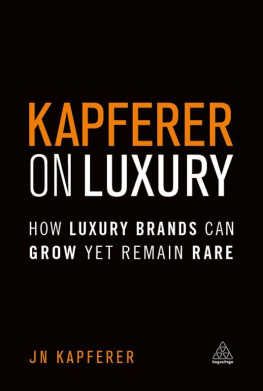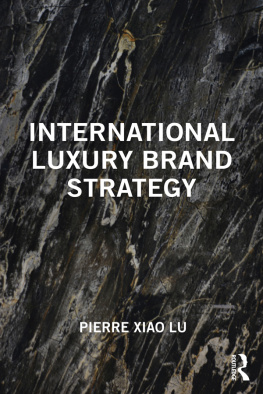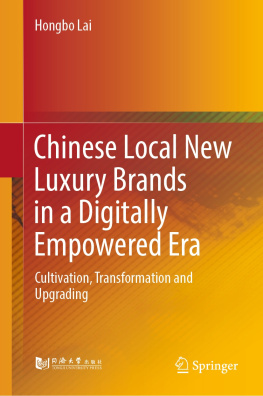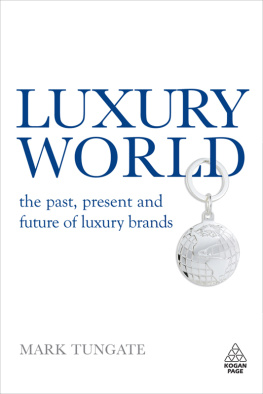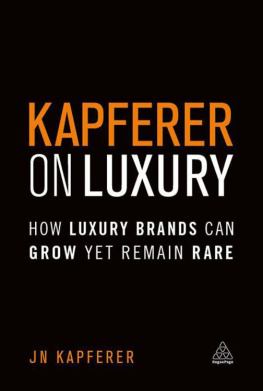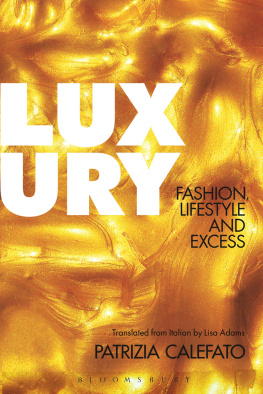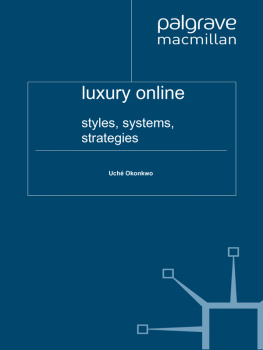Jean-Noël Kapferer - Kapferer on Luxury: How Luxury Brands Can Grow Yet Remain Rare
Here you can read online Jean-Noël Kapferer - Kapferer on Luxury: How Luxury Brands Can Grow Yet Remain Rare full text of the book (entire story) in english for free. Download pdf and epub, get meaning, cover and reviews about this ebook. year: 2015, publisher: Kogan Page, genre: Romance novel. Description of the work, (preface) as well as reviews are available. Best literature library LitArk.com created for fans of good reading and offers a wide selection of genres:
Romance novel
Science fiction
Adventure
Detective
Science
History
Home and family
Prose
Art
Politics
Computer
Non-fiction
Religion
Business
Children
Humor
Choose a favorite category and find really read worthwhile books. Enjoy immersion in the world of imagination, feel the emotions of the characters or learn something new for yourself, make an fascinating discovery.
- Book:Kapferer on Luxury: How Luxury Brands Can Grow Yet Remain Rare
- Author:
- Publisher:Kogan Page
- Genre:
- Year:2015
- Rating:4 / 5
- Favourites:Add to favourites
- Your mark:
- 80
- 1
- 2
- 3
- 4
- 5
Kapferer on Luxury: How Luxury Brands Can Grow Yet Remain Rare: summary, description and annotation
We offer to read an annotation, description, summary or preface (depends on what the author of the book "Kapferer on Luxury: How Luxury Brands Can Grow Yet Remain Rare" wrote himself). If you haven't found the necessary information about the book — write in the comments, we will try to find it.
Kapferer on Luxury: How Luxury Brands Can Grow Yet Remain Rare — read online for free the complete book (whole text) full work
Below is the text of the book, divided by pages. System saving the place of the last page read, allows you to conveniently read the book "Kapferer on Luxury: How Luxury Brands Can Grow Yet Remain Rare" online for free, without having to search again every time where you left off. Put a bookmark, and you can go to the page where you finished reading at any time.
Font size:
Interval:
Bookmark:
Other books by
Jean-Nol Kapferer published by Kogan Page
The Luxury Strategy: Break the rules of marketing to build luxury brands , Second edition, by Jean-Nol Kapferer and Vincent Bastien
(isbn 978 0 7494 6491 2)
The New Strategic Brand Management: Advanced insights and strategic thinking , Fifth edition, by Jean-Nol Kapferer
(isbn 978 0 7494 6515 5)

This ebook published in 2015 by
Kogan Page Limited
2nd Floor, 45 Gee Street
London EC1V 3RS
United Kingdom
www.koganpage.com
Jean-Nol Kapferer 2015
E-ISBN 978 0 7494 7437 9
CONTENTS
L uxury is an industry like no other: it is the only one for which growth creates a problem. Is a lack of demand the source of the problem? No, the problem is just the opposite: excess of demand. For example, how many more Ferraris should the brand sell each year without endangering its dream value and profits? Should Herms decide not to sell more Kelly bags this year than last year? When should Louis Vuitton decide to reduce its number of stores in a given country?
Yet, outside the doors of luxury stores, ordinary people want to access the banquet. They can now enter the websites and social networking pages of these stores. Luxury symbolizes their access to a life that is as happy as the celebrities they observe wearing such luxury dresses or watches, which they have long been coveting from watching Western movies, news and television series.
In the luxury market, clients not only buy an exceptional product partly handmade, with the savoir faire of artisans but also a legend: a great tradition made modern to fit ones present life, a culture anchored in a country. In addition, they also buy exclusivity, though this does not mean buying the only copy in the world. Luxury products are not paintings. Exclusivity means that the brand is purposely limiting demand: the higher price reflects the price paid for gaining the right to be associated with selected, affluent co-consumers. To paraphrase Groucho Marx: I would never want to be part of a club that would accept me. This exclusivity factor is what distinguishes luxury from premium brands and, all the more so, from masstige (mass prestige) brands. Mercedes-Benz now competes against Audi, BMW and Lexus in volume: with BMW leading the flock with 1.66 million cars sold in 2013. Should there be a limit to the sales objectives of Mercedes S-Class in the forthcoming years? Probably not. In contrast, Rolls-Royce will purposely sell one car less next year than this year, but each car will be tailor-made. The company makes more money by customizing each Rolls-Royce to the individual owner than by selling one more car. Doing so creates the image of more exclusivity and value. Managing a luxury brand does not mean running after the maximum number of customers but rather the right ones associated with their own status. Goods are chosen when one knows who else is selecting and wearing them for example, fashion relies heavily on celebrities to sell its products. However, luxury is not fashion, as is discussed in The Luxury Strategy (2012), which I co-authored with Vincent Bastien.
Growth in luxury is a fragile concept and a mixed blessing. When does saturation occur? Too few clients prevent brands from covering the considerable fixed costs of luxury retail. Today, niche is out: an unknown luxury brand cannot accumulate the symbolic capital needed to endow its clients with status and respect. But too many clients endanger the exclusivity factor and the luxury experience of these clients. How many people are now wearing Chanel eyewear logos on the streets of Paris, bought in regular optician chain stores? Even in flagship stores the luxury in-store experience can become damaged because of the long queues and the lack of attention from minimal staff. What level of service is really delivered in the retail stores of luxury brands? At stake here are the brand value and its ability to command a high price premium without any form of justification.
Luxury as a sector is becoming consolidated as a result of the problems raised by growth. How fast should a firm grow? Where in the world should it do so? How much volume should it sell? According to Bain & Company data, Italian brands have the highest rate of sales growth in the world, even higher than French brands. However, many of the Italian icons have been bought by French groups (such as Mot Hennessy Louis Vuitton (LVMH) and Kering). Growth needs cash and know-how, and family companies may not have enough of either. Many formerly independent family companies have sold to luxury groups, even those that said they would never do so (such as Bulgari, Loro Piana and Gucci). By contrast, some family companies, such as Herms and Chanel, are great cash machines and remarkably profitable.
Wall Street interest in luxury groups rests on two parameters: the luxurious margins that this sector provides and the growth of the market. Therefore, because luxury groups are listed on the stock exchange, there will be continued pressure on growth objectives, something that the independent family companies will not have to bear. So far, Wall Street has been well served by the booming expansion of this industry since 1990:
Horizontal expansion has occurred, due to the conquest of the BRIC countries (Brazil, Russia, India and China) and now the MINT countries (Mexico, Indonesia, Nigeria and Turkey). China is the most symbolic and powerful proof of this expansion. An example is the success of Louis Vuitton in China: the brand now symbolizes the economic success of the country itself, with stores opening in first-tier and now even second-tier cities.Luxury brands have also experienced vertical expansion, with the creation of second and third lines. The most typical example is Armani. Another sign of vertical expansion is the growth of accessories as a major source of profitability.Luxury brands have also engaged in diversification, abandoning their former single specialization to encompass a wider range of products. The goal of such brand extension is to profitably develop directly operated stores. Diversification is also an answer to the problem created by new clients of luxury that is, the absence of loyalty. New clients choose brands by contagion of desire, not by adhesion to their values, nor by connoisseurship. Extension of luxury lines provides another reason for consumers to visit boutique stores or company websites.But what comes next, after horizontal and vertical expansion and diversification? More of the same? How, then, will the luxury sector overcome the chasm between the images it promotes continuously defining luxury as rare, noble, crafted, exclusive, spirited, elevating and servicing and the realities of business growth?
This book aims to propose insights into possible growth issues for luxury, and maybe even foresight. We analyse the current artification of luxury and the rise of abundant rarity strategies that help to sustain the luxury dream with higher volumes. We also discuss the internet challenges in a renewed way and present sustainable development issues. Finally, we address the management itself of luxury companies and groups.
The book includes some of my recent articles (some co-authored) published in international journals, addressing the issues of growth and its many distinct facets. Each of them can be read on its own. In addition, it includes several original chapters pertaining to issues not covered in these published articles and new data from our latest international research on the levers of the luxury dream in the minds of the customers in the luxury sector. This book serves as a companion book to The Luxury Strategy , which remains the international reference for managing luxury brands in a distinctive way, to sustain the gap between luxury and fashion or premium.
Next pageFont size:
Interval:
Bookmark:
Similar books «Kapferer on Luxury: How Luxury Brands Can Grow Yet Remain Rare»
Look at similar books to Kapferer on Luxury: How Luxury Brands Can Grow Yet Remain Rare. We have selected literature similar in name and meaning in the hope of providing readers with more options to find new, interesting, not yet read works.
Discussion, reviews of the book Kapferer on Luxury: How Luxury Brands Can Grow Yet Remain Rare and just readers' own opinions. Leave your comments, write what you think about the work, its meaning or the main characters. Specify what exactly you liked and what you didn't like, and why you think so.

